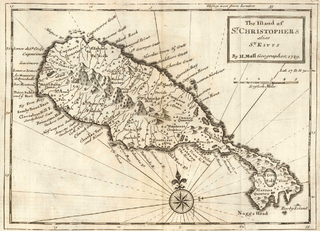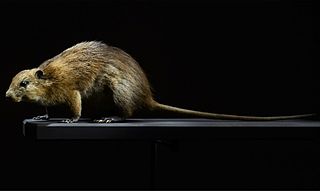Related Research Articles

Anguilla is a British Overseas Territory in the Caribbean. It is one of the most northerly of the Leeward Islands in the Lesser Antilles, lying east of Puerto Rico and the Virgin Islands and directly north of Saint Martin. The territory consists of the main island of Anguilla, approximately 16 miles long by 3 miles (5 km) wide at its widest point, together with a number of much smaller islands and cays with no permanent population. The territory's capital is The Valley. The total land area of the territory is 35 square miles (91 km2), with a population of approximately 15,753 (2021).

Nevis is a small island in the Caribbean Sea that forms part of the inner arc of the Leeward Islands chain of the West Indies. Nevis and the neighbouring island of Saint Kitts constitute the Federation of Saint Kitts and Nevis, a singular nation state. Nevis is located near the northern end of the Lesser Antilles archipelago about 350 kilometres (220 mi) east-southeast of Puerto Rico and 80 kilometres (50 mi) west of Antigua. Its area is 93 square kilometres (36 sq mi) and the capital is Charlestown.

Saint Kitts and Nevis, officially the Federation of Saint Christopher and Nevis, is an island country and microstate consisting of the two islands of Saint Kitts and Nevis, both located in the West Indies, in the Leeward Islands chain of the Lesser Antilles. With 261 square kilometres (101 sq mi) of territory, and roughly 50,000 inhabitants, it is the smallest sovereign state in the Western Hemisphere, in both area and population, as well as the world's smallest sovereign federation. The country is a Commonwealth realm, with Charles III as King and head of state. It is the only sovereign federation in the Caribbean.

Saint Kitts and Nevis have one of the longest written histories in the Caribbean, both islands being among Spain's and England's first colonies in the archipelago. Despite being only two miles apart and quite diminutive in size, Saint Kitts and Nevis were widely recognized as being separate entities with distinct identities until they were forcibly united in the late 19th century.

Saint Lucia was inhabited by the Arawak and Kalinago Caribs before European contact in the early 16th century. It was colonized by the British and French in the 17th century and was the subject of several possession changes until 1814, when it was ceded to the British by France for the final time. In 1958, St. Lucia joined the short-lived semi-autonomous West Indies Federation. Saint Lucia was an associated state of the United Kingdom from 1967 to 1979 and then gained full independence on February 22, 1979.
The history of Anguilla runs from the beginning of human habitation, probably via settlement from South America, through its colonization by the English in the early modern period, to the present day. Following a series of rebellions and a short-lived period as an independent republic during the 1960s, Anguilla has been a separate British overseas territory since 1980.

The British West Indies (BWI) were colonised British territories in the West Indies: Anguilla, the Cayman Islands, Turks and Caicos Islands, Montserrat, the British Virgin Islands, Antigua and Barbuda, The Bahamas, Barbados, Dominica, Grenada, Jamaica, Saint Kitts and Nevis, Saint Lucia, Saint Vincent and the Grenadines, British Guiana and Trinidad and Tobago. Other territories include Bermuda, and the former British Honduras. The colonies were also at the centre of the transatlantic slave trade, around 2.3 million slaves were brought to the British Caribbean. Before the decolonisation period in the later 1950s and 1960s the term was used to include all British colonies in the region as part of the British Empire. Following the independence of most of the territories from the United Kingdom, the term Commonwealth Caribbean is now used.

Saint Christopher-Nevis-Anguilla was a British colony in the West Indies from 1882 to 1983, consisting of the islands of Anguilla, Nevis, and Saint Christopher. From 1882 to 1951, and again from 1980, the colony was known simply as Saint Christopher and Nevis. Saint Christopher and Nevis gained independence in 1983 as the Federation of Saint Kitts and Nevis, while Anguilla would remain a British overseas territory.

Megalomys desmarestii, also known as the Martinique muskrat, Desmarest's pilorie, or the Martinique giant rice rat, is an extinct rice rat from Martinique in the Caribbean.
Francis Willoughby, 5th Baron Willoughby of Parham was an English peer of the House of Lords.

The term British West Indies refers to the former English and British colonies and the present-day overseas territories of the United Kingdom in the Caribbean.

The British Leeward Islands was a British colony from 1671 to 1958, consisting of the English overseas possessions in the Leeward Islands. It ceased to exist from 1816 to 1833, during which time it was split into two separate colonies. It was dissolved in 1958 after the separation of the British Virgin Islands, and the remaining islands became parts of the West Indies Federation.
Jean Fleury was a French naval officer and privateer. He is best known for the capture of two out of the three Spanish galleons carrying the Aztec treasure of Hernán Cortés from Mexico to Spain and one ship from Santo Domingo in 1522. This was one of the earliest recorded acts of piracy against the new Spanish Empire and encouraged the French Corsairs, Dutch Sea Beggars and English Sea Dogs to begin attacking shipping and settlements in the Spanish Main during the next several decades.

The Caribbean is a subregion of the Americas that includes the Caribbean Sea and its islands, some of which are surrounded by the Caribbean Sea and some of which border both the Caribbean Sea and the North Atlantic Ocean; the nearby coastal areas on the mainland are often also included in the region. The region is southeast of the Gulf of Mexico and the North American mainland, east of Central America, and north of South America.
The Jamaican wood rail, also called the Jamaican uniform rail was the nominate subspecies of the uniform crake found on Jamaica. It became extinct around 1881.
Gerald F. Schroedl is a professor of anthropology at the University of Tennessee. He specializes in Southeastern United States and Caribbean prehistoric and historic archaeological sites. He is an authority on Cherokee prehistory and the archaeology of eastern Tennessee and western North Carolina.

The Battle of St. Kitts or St. Cristopher was a successful Spanish expedition that seized the islands of Saint Kitts and Nevis from the English and French during the Anglo-Spanish War (1625–30).
The Attack on Saint Martin was a failed attempt by the Dutch Republic to recapture the island and former base of the Dutch West India Company (WIC) from the Spanish. In 1633 the Spanish had invaded Saint-Martin and Anguilla, driving off the French and Dutch inhabitants. The French and Dutch banded together to repel the Spanish and it was during a 1644 sea battle that the Dutch commander Peter Stuyvesant, later the governor of New Amsterdam, unsuccessfully besieged Fort Amsterdam and was forced to retreat with the loss of hundreds of men. A stray Spanish cannonball shattered his leg, which had to be amputated. But luck was on the Dutch side, and when the Eighty Years' War between Spain and the Netherlands ended, the Spanish no longer needed a Caribbean base and just sailed away in 1648.
Thomas Sutton was the speaker of the House of Assembly of Jamaica in 1691-92 and 1698.

The primary law governing Saint Kitts and Nevis nationality regulations is the Saint Christopher and Nevis Citizenship Act, which came into force on 28 February 1984.
References
- ↑ C. S. S. Higham, M.A. CUP Archive. pp. 34–5. GGKEY:ATDPR6GCKJ8.
- ↑ "Anguilla". World Statesmen. Retrieved 22 November 2011.
- ↑ Rachel Selbach; Hugo C. Cardoso; Margot van den Berg (2009). Gradual Creolization: Studies Celebrating Jacques Arends. John Benjamins Publishing. p. 154 note 6. ISBN 978-90-272-5256-2.
- ↑ Louis H. Roper; Bertrand Van Ruymbeke (2007). Constructing Early Modern Empires: Proprietary Ventures in the Atlantic World, 1500-1750. BRILL. p. 203. ISBN 978-90-04-15676-0.
- ↑ David Watts (22 March 1990). The West Indies: Patterns of Development, Culture and Environmental Change Since 1492. Cambridge University Press. p. 224. ISBN 978-0-521-38651-7.
- ↑ David Watts (22 March 1990). The West Indies: Patterns of Development, Culture and Environmental Change Since 1492. Cambridge University Press. p. 242. ISBN 978-0-521-38651-7.